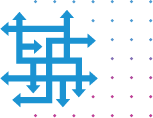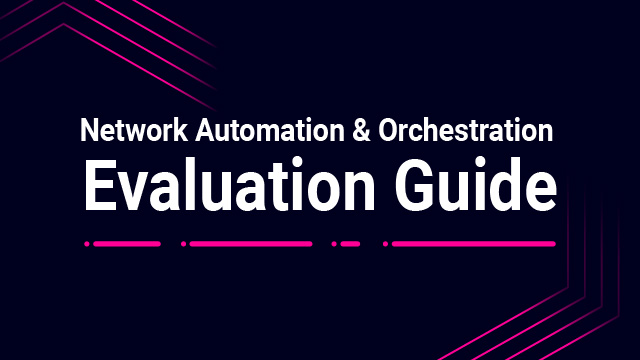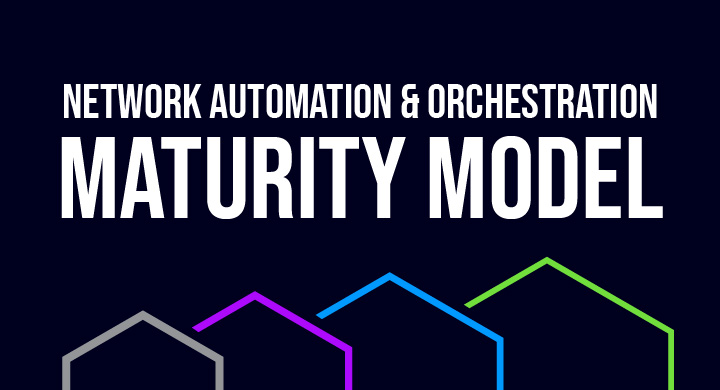Itential believes the only way to truly adopt modern, programmable networks is through automation. Our Guiding Principles serve as a blueprint for how organizations should approach network automation and how to lay the proper foundation for success now and into the future.
Overview
Your Blueprint for Evolving Network Automation for Next-Gen Programmable Networks
As the network evolves into a more dynamic environment due to the introduction of new concepts such as virtualization and software-defined everything, it is becoming imperative that operators must automate as much as possible. Whether it be software-defined WAN, data center, cloud, or networking in general, it is clear that the age of network programmability is upon us. So, what does this mean for network automation? How does it evolve to support new technologies while still addressing integration into existing legacy ecosystems? How does it scale to support physical, virtual, and cloud networks?
Itential is committed to accelerating the move toward software-driven networks and next-generation, agile network operations to address these challenges. These eight Guiding Principles are the backbone to a successful network automation strategy. Below we break down the drivers behind each Guiding Principle as well as how network automation plays a role for each and the critical functions that the solutions should embrace.

1. Networks are Critical for Digital Transformation
The simple days of the network being a commodity and managed as “just the pipes” is over. Today’s modern network must be as agile to deploy and change as the other technologies it supports. Since digital transformation cannot occur without a strong network to support it, today’s businesses require a network that can quickly adjust to evolving requirements that enable new services, processes, and models.
The network is the core to digital transformation.

From Bottleneck to Strategic Partner
Network teams have to keep up with the speed of business to help drive new and differentiated services by adopting vendor agnostic automation in order to utilize all technologies both old and new.
Current State
Bottleneck to Transformation
The network is seen as the bottleneck to innovation instead of a strategic partner within IT. Most network teams are viewed as slow to change and reactive as opposed to a strategic enabler.
Future State
Strategic Partner
The network will be a strategic partner for innovation and digital transformation, keeping up with the speed of business. Network teams will be capable of driving new and differentiated services for the business with operational readiness to support digital transformation efforts.
How Network Automation Gets You There
By adopting network automation, organizations can re-think the way they traditionally manage their networks in order to optimize network and infrastructure operations, lower costs, and simplify and/or increase agility in an effort to support new levels of innovation and company growth.
Network Automation Solutions Should Embrace
API-First Approach
![]()
As network infrastructure continues to evolve to become more programmable and treated as software, it is critical that organizations evolve their existing CLI-based automations with APIs.
Automation Analytics
![]()
Organizations need the ability to make informed decisions about which network automation use cases will drive the most value to their digital transformation initiatives.
Self-Service Capabilities
![]()
The core of digital transformation is enabling internal teams and customers with the ability for on-demand self-service and network automation provides the platform to easily do so.

2. Modern Networks Span Multiple Domains & Are More Complex
Today’s networks are becoming more complex and distributed, spanning physical, virtual, and cloud. Today’s enterprise IT systems and applications live on multiple and differing infrastructures, with each configured and managed by different systems that offer no common network model.
With unprecedented increases in network complexity and scale, automation is imperative to help IT teams deliver consistent network and service levels.

From Siloed to Connected Management
In order to address the span of all domains and increasing complexity, networks must be managed in a way that speaks the same language and can handle any existing or new technologies by moving from siloed point solutions to a connected, holistic view.
Current State
Siloed Management
The network is managed in silos with fragmented teams and data. Network teams utilize point solutions and siloed skills and teams across multiple domains and departments.
Future State
Connected Management
Network teams will manage their network with multiple network controllers, orchestrators, and systems with a rich set of API capabilities. They will adopt an automation solution that can handle the complexity and create automations that can work across any existing and future systems through an API-first approach.
How Network Automation Gets You There
By adopting network automation, organizations can leverage a unified solution that brings all of their existing infrastructure and tools together into a connected and automated environment in order to deliver reliable and consistent network and service levels.
Network Automation Solutions Should Embrace
Multi-Domain & Multi-Vendor Support
![]()
Organizations require a horizontal and vendor agnostic solution that connects all your systems and technologies for full end-to-end automation and orchestration to remove the siloes they’re currently stuck in.
Rapid Integration
![]()
A fundamental need of connected management is the ability to easily and quickly integrate with anything in your ecosystem to provide a single, aggregated network API.
Configuration Management
![]()
Network infrastructure is now distributed which means network teams must have a cohesive way to manage configuration, compliance, and remediation of all of their network devices, regardless of whether they are physical, virtual, or cloud-native.

3. How We Manage the Network is as Critical as Speeds & Feeds
There has been a lack of investment in network management plane solutions, which puts more pressure on the network to perform. As the management plane is primarily made up of teams within siloed organizations, they are plagued with fragmented management domains and tool choices that make standardization nearly impossible.
Not to mention, the fear of failure holds them back from moving faster as manual errors can cause major network outages.

From Reactive to Proactive
As modern networks are generating massive amounts of work that exceeds the ability of human operations to manage or even understand in a timely manner, automation is becoming increasingly necessary to rethink traditional network management.
Current State
Reactive
The network is managed in a very reactive way aimed at maintaining the status quo through manual operations just to keep the lights on. There is a lack of skills and resources hindering teams from even getting started with automation. This reactive approach leads to a never-ending backlog of mundane, but important, networking tasks that steal valuable time from the networking team.
Future State
Proactive
The network is managed in an environment that reduces the time needed to complete tasks and reduces errors along the way, allowing teams the time to get ahead of their backlog and start managing in a more proactive way with an automation solution. This allows multiple teams to build useful automations and not just complete tasks, thus focusing on higher priority activities like tuning and improving the existing network infrastructure.
How Network Automation Gets You There
By adopting network automation, organizations can begin to look past simply keeping the lights on by automating routine tasks. This allows their teams to get more done in the same amount of time and start looking ahead, instead of constantly being bogged down by the backlog.
Network Automation Solutions Should Embrace
Low-Code
![]()
By utilizing a low-code, drag-and-drop interface, network engineers can easily design, build, and visualize repeatable automations without needing to learn code.
End-to-End Automation
![]()
It’s impossible for people alone to manage the modern network, therefore they must look further than automating the execution of a task to automating the full end-to-end process from ticket opening to closure.
Network Intelligence
![]()
With a network intelligent enabled platform, teams can quickly build end-to-end operational automations through the ability to consume, understand, and execute network specific tasks.

4. Increased Utilization of Multi-Cloud & Edge Services
The expansion into the hybrid and multi-cloud world means that networking teams are tasked with managing everchanging variables (apps, data, users, and devices) that span every domain of a business. As a result, teams must work together to tackle everything from the network implications of public cloud and SaaS providers.
As managing hybrid and multi-cloud environments increases complexity even further, automation is becoming increasingly necessary to enable many next-generation experiences.

From Siloed to Integrated Teams
In order to fully utilize multi-cloud and edge services, teams must find a way to work together so that all domains can be managed as one in order to drive network automation through a programmable network.
Current State
Siloed Teams
The network and cloud teams operate in silos and they have little to no interaction with each other. This causes disconnect and severely slows down the time to complete any network activity.
Future State
Integrated Teams
Network and cloud teams will integrate into a single team and have knowledge and access to each domain through an automation solution that allows for the integration with a wide range of cloud services and cloud service providers.
How Network Automation Gets You There
By adopting network automation, organizations can break down the barriers between cloud and network teams through a shared platform that facilitates the integration and automation needs across both teams in a common language.
Network Automation Solutions Should Embrace
Support for Multi-Cloud & Hybrid-Cloud Networking
![]()
The growing demand for cloud networking services makes it essential for a solution to enable network engineers and cloud architects to automate across multi-cloud networks.
Reusable Automations
![]()
Merged teams also requires a centralized platform that empowers each team to rapidly build automations that provide immediate value and are available for other teams to leverage with their own work.
Role Based Access Control
![]()
The merging of teams requires flexibility and control over permissions to components and data across all cloud environments, ensuring each user is able to access and automate what’s needed.

5. Networks Require an ‘All-of-the-Above’ & ‘Right Tool, Right Job’ Strategy
As networks have evolved, so have the tools and systems to support and manage across domains. The amount of time and complexity it takes to create a new service or change an existing one is ever-increasing. Unfortunately, there is no one tool to rule them all as each tool is designed for different domains.
As a result, automation is becoming increasingly necessary to leverage all of your tools and systems, and well as provide the flexibility to switch out and replace tools.

From Locked-In to Flexible
Teams are challenged with finding one tool to rule them all so they can create unified automation. This can only be done by finding a flexible alternative instead of being stuck operating in a vacuum with point solutions.
Current State
Locked-In
Network teams are stuck with siloed tools and management. This causes automation to happen in pockets, focused on tasks instead of full processes.
Future State
Flexible
Network teams will be able to bring their own automation and leverage the right tool for the right job, providing the freedom to interchange tools as needed to have the best of breed instead of vendor lock-in.
How Network Automation Gets You There
By adopting network automation, organizations can leverage a unified approach, connecting all of their tools, allowing for the use of the right tool for the right job, regardless of domain or vendor.
Network Automation Solutions Should Embrace
Bring Your Own Automation
![]()
Your automation solution should meet you where you are by leveraging existing automation investments so that no more tools are required to reach your desired state.
Build Your Own Integrations
![]()
Not every tool provides an out-of-the-box integration or API, teams need the ability to easily build integrations between their solutions.
Federation of Data
![]()
Your automations are only as good as your data, so a solution must aggregate and harmonize the data to enable a global view, allowing teams to automate across more domains with better data visibility.

6. Networks are Not Centralized & Contain a Distributed Source of Truth
Along with multiple tools comes multiple authoritative data repositories for different classes of information (IPAM, network discovery, network controllers, SD-WAN, and class network configuration tools). In the modern network era, network engineers aren’t afforded the luxury of lead time to gather data by accessing or swivel chairing across each individual source of truth. Without automation across multiple sources of truth, each new source adds an additional delay in deploying new applications and services because of the human intervention required to gather data. These delays add up quickly, and they are one of the overlooked reasons as to why there is so much backlog attached to deploying network infrastructure.
As your team onboards more tools with even more data, automation requires a view into various sources of truth.

From Scattered to Unified View of Distributed Sources of Truth
Network teams are challenged with finding the right data at the right time as they have to navigate between multiple sources truth. A unified source of truth is needed in order to conduct proper automation.
Current State
Scattered View of Distributed Sources of Truth
Network Engineers have to manage disparate sources of truth. This proves difficult to refer to multiple sources efficiently and near impossible to make decisions and changes.
Future State
Unified View of Distributed Sources of Truth
Network engineers will leverage a platform that integrates with each source of truth and can federate data from these systems as needed for any network automation to create a unified source of truth.
How Network Automation Gets You There
By adopting network automation, organizations can adopt a distributed source of truth by allowing the systems of record and their data to act as the source of truth, mitigating data quality issues and manual errors.
Network Automation Solutions Should Embrace
API-First
![]()
The only way to integrate multiple sources of truth into a unified one is through an API first approach, allowing your systems to talk to each other.
Data Federation & Transformation
![]()
Having unified sources of truth is only impactful when you can fully integrate the data together, while ensuring it speaks the same language.
Unified View
![]()
An abstracted and federated view of the data, processes, and logic from integrated systems enables a single pane of glass across your entire network and management tools for simplifying automation across your organization.

7. Organizations Must Have Trust in Their Data, Tools, & Processes
Bad data limits your ability to automate. Multiple systems mean an increased blast radius and more time to correct by people therefore the data, tools, and processes must be error prone.
As manual operations increase the risk for errors and downtime, automation is imperative to mitigate that risk and provide trust.

From Human to Machine Centric
In order to have full trust in their automations, teams must find a solution with a machine-centric focus that allows them to increase automation as they grow trust in the data, tools, and processes.
Current State
Human-Centric
Automations are based on human-centric tasks so that teams have full control over any task and in some cases, there is no automation at all.
Future State
Machine-Centric
Automations are based on machine-first network automation platform that is designed to move at your own pace based on proven trust.
How Network Automation Gets You There
By adopting network automation, organizations can start small by automating at their own pace and gradually expand their automation efforts one task at a time until they are confident in the data, tools, and processes to eventually reach a fully automated state.
Network Automation Solutions Should Embrace
Best Practice Use Case
![]()
There’s no need to start figuring out the best practices on your own when you can leverage an automation already built based on industry and use cases best practices, increasing trust in the process.
Form Driven Automation
![]()
The ability to capture tribal knowledge and use in a form driven automation ensures entire teams are using the right processes and data.
Human Checkpoints
![]()
The right platform should allow full control over when and where human checkpoints are required so you can automate at your own pace with rollback capabilities.

8. Infrastructure as Code is the Future of Network Automation
Network teams must find a way to extend DevOps principles to the network. Network professionals need to move up the stack and develop a skillset around automation and programmability, so networks operate with minimal operator intervention other than desired state requirements.
As teams architect for autonomous networking, pipeline-based automation is imperative to increase network stability and availability both during and after a change.

From Manual to Software Mindset
Network teams are haunted with backlogs they can’t complete fast enough. In order to rapidly deploy any type of network infrastructure, teams must find a solution that treats the network as software relying on DevOps practices to rapidly deploy network infrastructure.
Current State
Manual Mindset
Network teams have very little or no network automation, with a growing set of systems, network devices, and users. This has built a backlog teams can’t get out of and no way to banish it.
Future State
Software Mindset
Network teams will treat the network as software, using CI/CD processes to rapidly build, test, validate, and deploy any type of network infrastructure with the highest degree of trust and accuracy.
How Network Automation Gets You There
By adopting network automation, organizations can move toward treating the network like software.
Network Automation Solutions Should Embrace
CI/CD Processes
![]()
Network Engineers need a way to tweak the traditional pipeline into a NetOps pipeline that works for both engineers and software developers.
Programmability
![]()
In order for organizations to implement pipeline-based automation, a programmable network is required.
DevOps Mindset
![]()
While traditional DevOps principles may not match one to one in networking, a network automation solution should support a DevOps mindset so the network can be treated as software.
- 10 Questions to Ask When Evaluating the Right Network Automation Solution for Your Organization
- Why Network Automation Requires a ‘Right Tool, Right Job’ Strategy
- Why Build AND Buy Is the Model for Network Automation Success
- High-Code + Low-Code: How Network Teams Can Have the Best of Both Worlds for Network Automation
- How We Manage the Network is as Critical as Speeds & Feeds
- Why Customers Choose Itential for Network Automation & Orchestration
- The Days of Managing the Network as “Just the Pipes” is Over
- Driving Cloud Automation With Observability, AIOps, & NetDevOps
- How to Connect ServiceNow to Your Infrastructure with Itential
- Packet Pushers: From Automation to Orchestration for a FinTech Network
- How a Multinational Biotech Company Achieved Global Self-Service Networking with Itential
- Futuriom 50: Top Cloud Trends & Private Companies 2024
- Simplify How You Deploy, Track, & Manage Network Services with Itential’s Stateful Orchestration Capabilities
- Applying Platform Engineering Principles to Networking
Get Started with Itential
Schedule a Custom Demo
Schedule time with our automation experts to explore how our platform can help simplify and accelerate your automation journey.
Try Now for Free
Try Itential’s Automation Service free for 30 days, full access, no credit card required.
See Itential Products in Action
Watch demos of Itential's suite of network automation and orchestration products.


